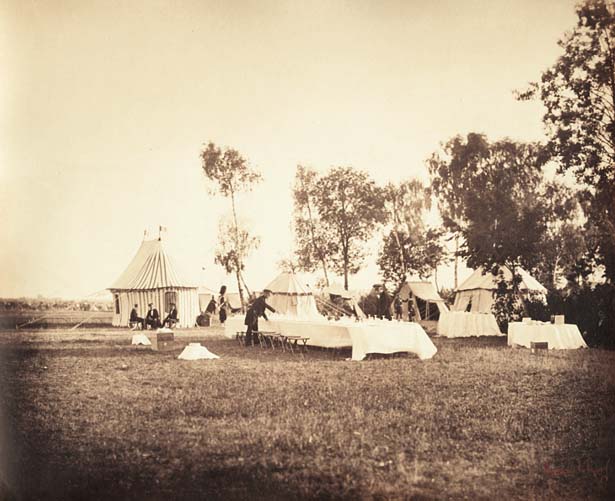
Abside de St. Sernin de Toulouse, 1851
Gustave Le Gray was born August 30, 1820 in Villiers-le-Bel, France.
For about three years at the beginning of the 1840s, Le Gray studied with the painter Paul Delaroche. Delaroche was noted for his quote about photography: "From today, painting is dead." Delaroche changed his mind somewhat, and preached the benefits of photographs as art studies. It is perhaps in his studio that Le Gray saw his first daguerreotype. In 1843 Delaroche disbanded his studio and announced his plans to go on to Italy. Le Gray apparently took up the painter's idea for this trip, actually preceding Delaroche by about a month. Italy was a country to which Le Gray was to return and where he married a young Roman woman, Palmira Leonardi, in 1844.
While shuttling between Rome and Paris and while attending the French Salons of 1848 and 1853, he became even more fascinated with the new art of photography. By the late 1840s Le Gray was still painting, but also making daguerreotypes and then salt paper prints. In 1849 he proposed a process based on paraffin-coated paper, and by 1850-52 he had developed new dry wax processes for paper negatives that gave his prints greater detail. At this time he started to teach photography and had many students, including other noted photographers such as J.B. Greene, Adrien Tournachon-Nadar, W.H. Guebhard, Leon-Eugene Mehedin, Adolphe Bilordeaux, Luigi Crette, Alphonse De Launay, F. E. Le Dien, Theodore de Banville, Henri Le Secq, Maxime Du Camp, Edouard and Benjamin Delessert, Jean Gasperd Roman, Gustave de Beaucorps, and Léon de Laborde. It is also possible that he taught both Charles Negre and even later Louis De Clercq his waxed paper negative techniques.

Navires de la Flotte Franco-Anglaise en Rade de Cherbourg, 1858
From 1849 through the early 1850s, Le Gray also documented the forest of Fontainebleau. In 1851 he became a founding member of the Société Héliographique, the first photographic organization in the world, and later became a member and officer of the Société Française de Photographie.
In 1851 Le Gray and Mestral were invited to join the Missions Héliographiques, a project to document important French architecture and monuments sponsored by the French Government. He worked with his friend Mestral. They embarked on a grand tour from the châteaux of Loire to Issoire, including the towns of Poitiers, Périgueux, Angouleme, Bordeaux, Moissac, Toulouse and Carcassonne. Their images from this series are among the rarest of the Missions Héliographiques, and most such prints reside only in French institutions.
In 1853, it was originally thought that he made another voyage to Italy with the photographer Firmin-Eugène Le Dien (December 18, 1817-July 28, 1865). Le Dien made numerous images of Rome, Pompeii and the Italian countryside with paper negatives, and Le Gray printed them. Some have Le Gray's stamp; many are numbered by Le Gray.
Le Gray was soon to abandon paper negatives himself for the new glass plate collodion negative process. He had already used collodion on paper, and was one of the first to use it on glass in early 1850. The shortened exposure time was important in capturing objects in motion. Le Gray began to use this new process on a series of Marine studies, which were largely of the French fleet, the Emperor's yacht and some ocean views with waves. These were a commercial success, and Le Gray sold prints even to the English photographic trade. There is some question about the type of print of many of these marine views, with one French conservator maintaining that some were perhaps salt rather than albumen prints. Le Gray also became well known for his portrait studies.
In 1857 at the request of Emperor Napoleon III, he made a photographic "report" on the operations at the military camp of Châlons. Approximately 15 Châlons albums are recorded in institutional and private collections. During the mid to late 1850s, Le Gray photographed key architectural views of Paris, of which there are very few known. It was a project that Le Gray reportedly made in the hope of receiving government support, which never materialized.
By 1860 Le Gray, facing mounting financial difficulties, left his wife and children and fled Paris. He went to Palermo in the company of the writer Alexander Dumas where he photographed the war in Italy and Garibaldi. His views of the war itself are quite rare. Parting company on unfriendly terms with Dumas, Le Gray and his friends went on to Lebanon, Syria and then Egypt in 1862, where Le Gray taught drawing in Cairo for a living and continued to photograph. Besides his portrait and commercial work, he produced a number of Egyptian scenes, particularly of the Pyramids and the Tombs of the Mamelouks, which are quite rare. He died in Cairo on July 29, 1884.
His work is in the collection of nearly every major museum. Today most critics would agree that Le Gray is the most influential 19th-century figure in photography. He was certainly one of the most colorful. The two most importants works on Gustave Le Gray are: Gustave Le Gray: 1820-1884, Sylvie Aubenas (Bibliotheque Nationale/J. Paul Getty Museum, 2002); and The Photography of Gustave Le Gray, Eugenia Janis (University of Chicago Press, 1987).
Exhibited and Sold By
Contemporary Works / Vintage Works, Ltd.
258 Inverness Circle
Chalfont, Pennsylvania 18914 USA
Contact Alex Novak and Marthe Smith
Email info@vintageworks.net
Phone +1-215-518-6962
Call for an Appointment





Share This